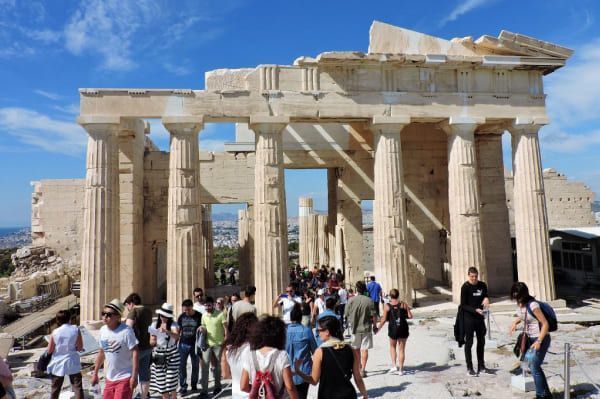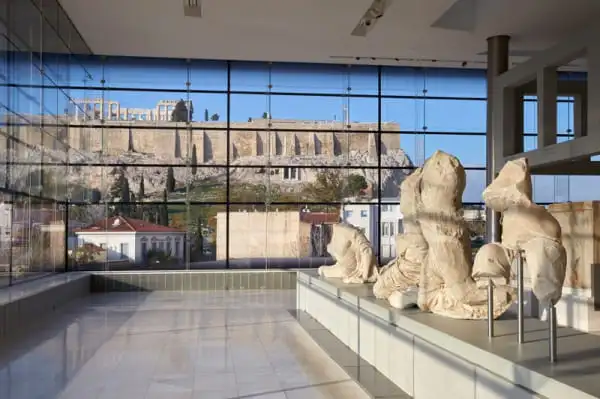
The Acropolis Museum: A Glimpse into Ancient Greece
The Acropolis Museum, situated at the foot of the Acropolis itself, is a must-visit for anyone interested in the glory of ancient Greece. Its modern design and layout beautifully complement the ancient artifacts it houses. The museum’s collection includes sculptures, architectural fragments, and artwork from the Acropolis, providing an in-depth understanding of this iconic site and its historical context. A Modern Architectural Wonder: Designed by architect Bernard Tschumi, the Acropolis Museum is a masterpiece of modern architecture. Its glass and concrete structure harmoniously blends with the historic surroundings while embracing the innovative spirit of the 21st century. The layout of the museum is an intricate dance of light and space, making the building itself an exhibit of artistry. A Collection of Treasures: The museum’s primary focus is on the archaeological findings from the Acropolis of Athens. Its collection includes a wide array of artifacts, ranging from monumental sculptures to everyday items used by the people of ancient Athens. One of the central highlights is the Parthenon Gallery, designed to replicate the dimensions and orientation of the Parthenon itself. Here, the original marble sculptures, including friezes and metopes, are displayed, allowing visitors to experience the grandeur of this iconic temple up close. A Home for the Elgin Marbles: The Acropolis Museum plays a central role in the ongoing debate over the Elgin Marbles, a collection of classical Greek marble sculptures, inscriptions, and architectural members removed from the Parthenon by Lord Elgin in the early 19th century. The museum was explicitly designed with the hope that these marbles, currently housed in the British Museum, would one day be returned to Greece to be reunited with the other half of their original collection. Cutting-Edge Conservation: The Acropolis Museum is not just a place for the static display of artifacts; it’s also at the forefront of conservation efforts. The museum boasts an advanced laboratory where experts work to restore and preserve the ancient sculptures and art. Visitors can watch the conservators at work through large glass windows, providing a unique opportunity to witness the meticulous care and expertise required to maintain these priceless treasures. A Window into the Past: As you explore the museum, you can trace the historical evolution of Athens, from its Mycenaean roots to the grandeur of the Classical era. The artifacts tell the story of a city that was not only a cradle of democracy but also a hub of culture and intellectual pursuit. A Connection Between Past and Present: The Acropolis Museum isn’t just a repository of ancient artifacts; it’s a place that bridges the gap between past and present. Its location near the Acropolis itself makes it the perfect companion to a visit to the ancient hill. You can gaze at the Parthenon from the museum’s panoramic windows, providing a stunning view that connects the historical context of the artifacts with their original site. A Cultural Center: Beyond its extensive collection, the Acropolis Museum serves as a cultural hub in Athens. It hosts a variety of temporary exhibitions, lectures, and educational programs, making it a dynamic space where contemporary Greece celebrates its ancient heritage. A Place for All: The Acropolis Museum is more than a treasure trove of artifacts; it’s a portal to the past, a testament to the enduring legacy of ancient Greece, and a symbol of the country’s cultural revival. Whether you’re an art enthusiast, a history buff, or simply a curious traveler, the museum offers a journey through time that reveals the profound impact of ancient Greece on the modern world. It’s a place where you can not only admire the past but also engage with the ongoing story of cultural preservation and heritage. The Acropolis Museum is, without a doubt, a must-visit destination for anyone exploring the historic city of Athens.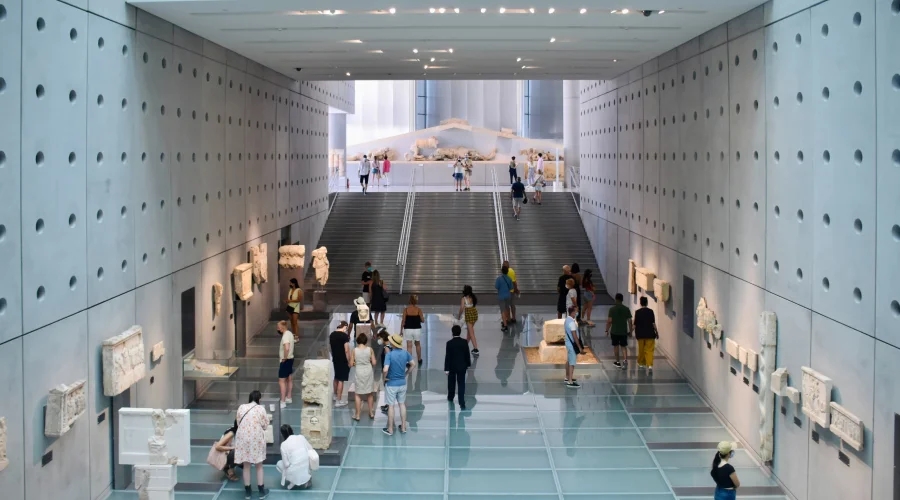
The National Archaeological Museum: A Treasure Trove of Antiquities
In the heart of Athens, where the echoes of ancient civilizations reverberate through the bustling streets, stands the National Archaeological Museum, a veritable treasure trove of antiquities that offers a fascinating journey through the history, art, and culture of Greece. Guardian of Greece’s Heritage: Established in 1829, the National Archaeological Museum is the largest and most comprehensive archaeological museum in Greece. It serves as the custodian of the nation’s archaeological heritage, with its collection spanning over 11,000 years of Greek history. A Monument to Antiquity: The museum’s collection is thoughtfully organized, guiding visitors through the chronological development of Greek civilization. From the Neolithic period to the Hellenistic era, you can trace the evolution of art, culture, and society through a rich array of artifacts. The Mycenaean Gallery: One of the highlights is the Mycenaean Gallery, which showcases treasures from the ancient city of Mycenae. Here, you can see the legendary Mask of Agamemnon, a gold funerary mask that once adorned a Mycenaean noble. This gallery provides a glimpse into the world of Homer’s epic tales and the historical reality that inspired them. The Antikythera Mechanism: Another jewel in the museum’s crown is the Antikythera Mechanism. Discovered in a shipwreck off the coast of the Greek island of Antikythera, this ancient analog computer is considered one of the most significant archaeological finds of the 20th century. It’s a remarkable piece of technology that dates back to the 2nd century BC and was used for astronomical and calendrical purposes. The Statue Collection: The museum’s sculpture collection is a true highlight, featuring a myriad of statues that reflect the artistic and aesthetic achievements of ancient Greece. Notable among these is the statue of Poseidon, the god of the sea, and the marble statue of Artemis, the goddess of the hunt. The Frescoes and Pottery: Greek pottery is another well-represented facet of the museum’s collection, including iconic red-figure and black-figure vases. The frescoes, including the stunning “Prince of the Lilies,” provide an intimate look into the everyday lives and religious practices of the ancient Greeks. A Hub of Cultural Activity: The National Archaeological Museum is not merely a repository of the past; it’s a vibrant cultural center. It hosts temporary exhibitions, educational programs, and lectures that allow visitors to delve deeper into the world of archaeology and ancient history. A Gateway to Greek Civilization: The National Archaeological Museum is a beacon that illuminates Greece’s rich cultural heritage. It’s a place where the ancient myths, legends, and historical accounts come to life through the artifacts left behind by those who lived in these lands millennia ago. A visit to this museum is a journey through time, a voyage that transports you to the very roots of Western civilization. It is a reminder that Greece’s contribution to art, philosophy, science, and democracy is an eternal legacy that continues to inspire and enrich our understanding of the past and the present. For anyone with an appreciation for history, art, and culture, this museum is an essential destination when exploring the wonders of Athens.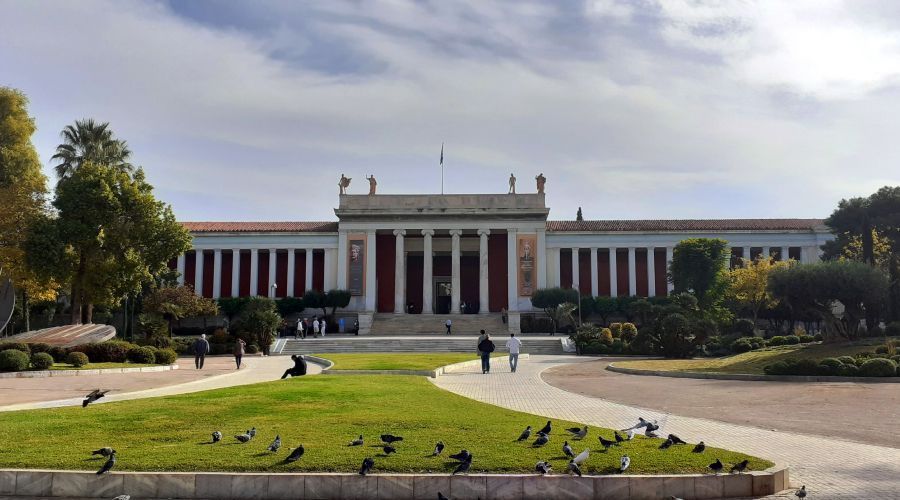
The Benaki Museum: A Journey Through Greek Culture
Tucked away in the heart of Athens, the Benaki Museum is a treasure trove of Greek culture, a remarkable institution that weaves together the threads of history, art, and heritage to create a captivating narrative of the Greek experience. A Testament to Philanthropy: Founded by Antonis Benakis in 1930, the museum stands as a testament to his passion for collecting and preserving the cultural heritage of Greece. Originally established to house his private collection, the Benaki Museum has grown over the years to encompass a diverse range of artworks, artifacts, and historical memorabilia. An Architectural Marvel: The museum is itself an architectural marvel, featuring a neoclassical building that was once the Benakis family home. The elegant structure reflects the aesthetic of early 20th-century Athens, with its marble facade and decorative elements. It’s a glimpse into the life of a prominent Greek family and their love for art and culture. A Rich and Diverse Collection: The Benaki Museum’s collection is a mosaic of Greek culture that spans centuries. From Byzantine icons and Ottoman-era ceramics to neoclassical paintings and contemporary art, the museum’s exhibits offer a comprehensive journey through Greece’s cultural evolution. The Greek War of Independence: One of the museum’s focal points is the Greek War of Independence exhibit, which provides an immersive experience of this critical period in Greek history. The collection includes rare documents, artifacts, and paintings that recount the struggle of the Greek people for their independence from Ottoman rule. The Yannis Pappas Studio: The Yannis Pappas Studio, part of the Benaki Museum’s modern art wing, is a vibrant space dedicated to the works of renowned Greek artist Yannis Pappas. His dynamic and colorful paintings are a testament to Greece’s artistic innovation in the 20th century. Contemporary Art: While the museum excels in showcasing Greece’s rich historical past, it also has a firm eye on the future with its commitment to contemporary art. Exhibits and installations by modern Greek artists add a dynamic and thought-provoking dimension to the museum’s offerings. A Window into Daily Life: The Benaki Museum doesn’t just focus on the grand narratives of Greek history; it also provides a window into the everyday lives of Greeks over the centuries. This is evident in the remarkable collection of decorative arts, textiles, and costumes that reveal the intricacies of daily existence. A Cultural Hub: The Benaki Museum is not just a place for quiet reflection and historical exploration; it’s also a hub of cultural activity. It hosts events, lectures, and educational programs that engage with contemporary issues, ensuring that the Greek cultural conversation remains vibrant and relevant. A Journey Through Time: The Benaki Museum is more than a repository of artifacts; it’s a living testament to Greece’s vibrant culture and the enduring legacy of its people. A visit to this museum is a journey through time, a voyage that unravels the many layers of Greek identity, from the grand epics of its history to the artistic and cultural expressions of the modern age. It is a place that invites you to walk in the footsteps of generations of Greeks, to experience their triumphs, struggles, and everyday moments. For anyone with an appreciation for the depth and diversity of Greek culture, the Benaki Museum is an essential stop when exploring the cultural tapestry of Athens.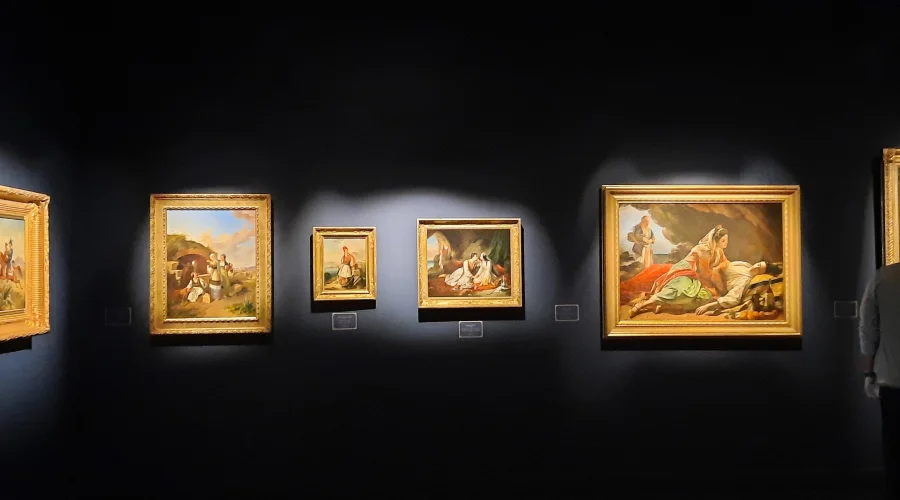
The Museum of Cycladic Art: Mystique of the Cyclades
In the heart of Athens, amid the echoes of ancient history and modern vibrancy, stands the Museum of Cycladic Art, a sanctuary of captivating antiquities that unveils the enigmatic allure of the Cyclades, a group of islands in the Aegean Sea that have left an indelible mark on history, art, and culture. A Tribute to the Cycladic Civilization: Founded by art collector and scholar Nicholas Goulandris and his wife Dolly, the Museum of Cycladic Art opened its doors in 1986. It was born out of a deep passion for the Cycladic islands and their unique contribution to the world of art. The Building Itself: An Artistic Marvel: The museum is housed in a neoclassical mansion on Neofytou Douka Street, a stone’s throw from the bustling Syntagma Square. The building’s graceful architecture sets the stage for the treasures it holds within, with its airy atrium and elegantly designed galleries. The Cycladic Collection: A Glimpse into Prehistory: The heart of the museum is its Cycladic collection, which comprises an impressive array of marble figurines and artifacts dating back to the Bronze Age. These enigmatic sculptures are known for their abstract and minimalist aesthetics, with their folded arms and serene expressions. They offer a glimpse into the prehistoric world of the Cyclades, shedding light on the art, religion, and society of these ancient islanders. Contemporary Art: A Dialogue Across Time: The Museum of Cycladic Art doesn’t confine itself to the past; it also features contemporary art exhibitions that explore the ongoing dialogue between modern artists and the Cycladic legacy. These exhibits provide a fresh perspective on how ancient traditions continue to inspire and influence contemporary artistic expressions. Educational Programs and Workshops: The museum actively engages with the public through a range of educational programs, workshops, and events. It’s not just a place for viewing art but also for understanding and experiencing it. Visitors of all ages can immerse themselves in the rich history of the Cyclades through these interactive initiatives. The Boutique: A Piece of the Cyclades in Athens: The museum’s boutique is a charming addition that offers visitors the opportunity to take home a piece of the Cycladic mystique. From Cycladic figurines and jewelry to books on art and history, the boutique is a treasure trove of gifts and souvenirs. A Glimpse into the Aegean: The Museum of Cycladic Art is more than a repository of historical artifacts; it’s a portal to the mesmerizing world of the Cyclades, a place where ancient enigma meets contemporary dialogue. A visit to this museum is not just an exploration of art and history but also an immersion into the mystique of a region that has inspired artists, scholars, and dreamers for centuries. The Cyclades are not just islands of white-washed buildings and crystal-clear waters; they are also the birthplace of a remarkable civilization that left its mark on the art and culture of ancient Greece. The Museum of Cycladic Art is an essential destination for anyone seeking to unravel the mysteries of these islands and their timeless allure. It is a place where the stories of ancient islanders come to life, where contemporary artists pay homage to a bygone era, and where visitors can embark on a journey through time and into the Cycladic mystique.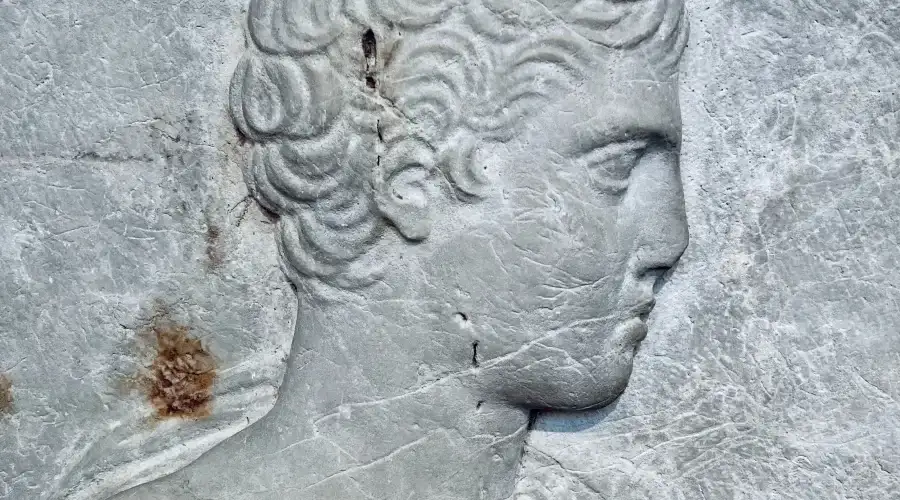
The Byzantine and Christian Museum: A Glimpse of Byzantium
In the heart of Athens, where the bustling city streets meet the whispers of ancient history, the Byzantine and Christian Museum stands as a sanctuary of art and culture, offering a captivating glimpse into the world of Byzantium and early Christianity. A Treasure Trove of Byzantine Art: Established in 1914, the Byzantine and Christian Museum is dedicated to preserving and showcasing the art, artifacts, and history of the Byzantine Empire and early Christianity. The Byzantine period, which spanned from the 4th to the 15th century, is known for its profound impact on art, culture, and religion. A Grand Neoclassical Building: Housed in an elegant neoclassical mansion on Vassilissis Sofias Avenue, the museum’s architecture itself is a work of art. The grandeur of the building is a fitting prelude to the riches held within its walls. Its neoclassical elements echo the historic era it represents. A Journey Through Time: The museum’s exhibits take visitors on a journey through time. The extensive collection includes icons, mosaics, frescoes, sculptures, manuscripts, jewelry, and everyday objects from the Byzantine era. It provides a comprehensive overview of the art, religious practices, and daily life of the people who lived during this historical epoch. Icons of Spiritual Expression: One of the central elements of the museum’s collection is its remarkable display of icons. Icons are not just works of art but also objects of profound religious significance. These religious paintings offer a glimpse into the spiritual life of Byzantine society, with their depictions of saints, biblical scenes, and religious narratives. Frescoes and Mosaics: The museum also features a rich collection of frescoes and mosaics, some of which have been transferred from churches and monasteries throughout Greece. These intricate works of art were central to the decoration of religious buildings and are a testament to the Byzantine Empire’s artistic excellence. Sacred Manuscripts: The museum’s collection of sacred manuscripts is a testament to the importance of the written word in Byzantine culture. Lavishly decorated manuscripts of the Bible and other religious texts showcase the skill and dedication of the scribes and artists of the time. A Hub of Education and Research: The Byzantine and Christian Museum is not just a repository of historical artifacts; it’s also a hub of education and research. It hosts lectures, seminars, and educational programs, ensuring that the rich heritage of Byzantium remains a living and evolving part of Greek culture. A Bridge to Early Christianity: The museum also sheds light on the early Christian period. With its early Christian artifacts and architectural elements, it connects visitors to the formative years of Christianity, highlighting the transition from a persecuted faith to an imperial religion. A Spiritual and Cultural Journey: The Byzantine and Christian Museum is more than a historical institution; it’s a spiritual and cultural journey through time. A visit to this museum is an exploration of the art and spirituality of a civilization that played a pivotal role in shaping the course of history. It’s a place where visitors can delve into the mystical world of icons, the intricate craftsmanship of frescoes and mosaics, and the enduring significance of early Christianity. The Byzantine and Christian Museum is a window into the Byzantine Empire’s profound influence on the Eastern Mediterranean and a testament to the enduring legacy of its culture and art.
The Museum of Islamic Art: A Cultural Bridge
In the heart of Athens, where the echoes of ancient history intertwine with contemporary vibrancy, the Museum of Islamic Athens Art serves as a unique cultural bridge, connecting Greece to the diverse world of Islamic art and heritage. It stands as a testament to the power of museums in fostering cross-cultural understanding. A Cultural Oasis in Athens: Established in 2019, the Museum of Islamic Athens Art is a relatively new addition to the city’s cultural landscape. Situated amidst the historic landmarks and contemporary life of Athens, it offers visitors a rare opportunity to explore the artistic and cultural treasures of the Islamic world. Architectural Elegance: The museum’s building itself is an architectural marvel, designed with modern aesthetics that blend harmoniously with the city’s historic surroundings. Its exterior and interior design, inspired by Islamic geometric patterns and motifs, reflect the artistry that is central to Islamic culture. A Kaleidoscope of Islamic Art: The museum’s collection is a treasure trove of Islamic art, ranging from ceramics, textiles, manuscripts, and calligraphy to metalwork, jewelry, and intricate architectural elements. It showcases the diverse artistic traditions that have flourished across the Islamic world, encompassing centuries of creativity and innovation. Intricate Calligraphy and Manuscripts: Islamic calligraphy, considered a sacred art form, takes center stage in the museum’s collection. Visitors can marvel at the exquisite precision and beauty of Arabic calligraphy on display. The museum also houses an array of manuscripts that reflect the intricate craftsmanship of scribes and the importance of the written word in Islamic culture. A Glimpse into Daily Life: The museum’s artifacts offer insights into the daily lives and traditions of people from the Islamic world. Visitors can explore objects such as intricately designed textiles, jewelry, and ceramics, revealing the rich tapestry of cultural expression that spans regions and eras. Cultural Exchange and Understanding: The Museum of Islamic Athens Art serves as a cultural bridge, promoting a deeper understanding of Islamic art, heritage, and culture among Greek and international audiences. It invites visitors to explore the connections between different civilizations, emphasizing the shared elements of human culture that transcend borders and boundaries. A Hub of Education and Dialogue: Beyond its collection, the museum is a hub for education and dialogue. It hosts exhibitions, lectures, workshops, and cultural events that engage with contemporary issues, fostering a dynamic space for cultural exchange and learning. An Athens Gem: The Museum of Islamic Athens Art is a remarkable cultural destination in the heart of Athens. It not only showcases the beauty and diversity of Islamic art but also embodies the essence of cultural exchange and dialogue. A visit to this museum is not just an exploration of art and culture; it’s an opportunity to appreciate the universal language of creativity and heritage. It’s a place where visitors can build bridges of understanding between different cultures and civilizations, and find inspiration in the shared threads of human culture. The Museum of Islamic Athens Art is a testament to the power of art and culture in uniting people and fostering cross-cultural appreciation.
Conclusion
Athens is a city where history and culture intersect at every corner, and its museums are the custodians of this rich heritage. From the artifacts of the Acropolis to the eclectic collection at the Benaki Museum, each institution offers a unique lens through which to view the layers of Greek history and culture. Whether you’re an art aficionado, a history buff, or simply a curious traveler, a visit to the museums of Athens promises a profound and enriching experience. These institutions are not just repositories of history but living testimonies to the enduring legacy of Greek civilization.More information
The Acropolis ticket grants visitors access to the archaeological site of the Acropolis and its slopes, including the Parthenon, the Theater…
The Acropolis of Athens is a testament to the rich history and culture of Greece and Western civilization. Over the centuries…
The Acropolis Museum is a modern museum located in Athens, Greece, which serves as a beacon for the preservation and…

